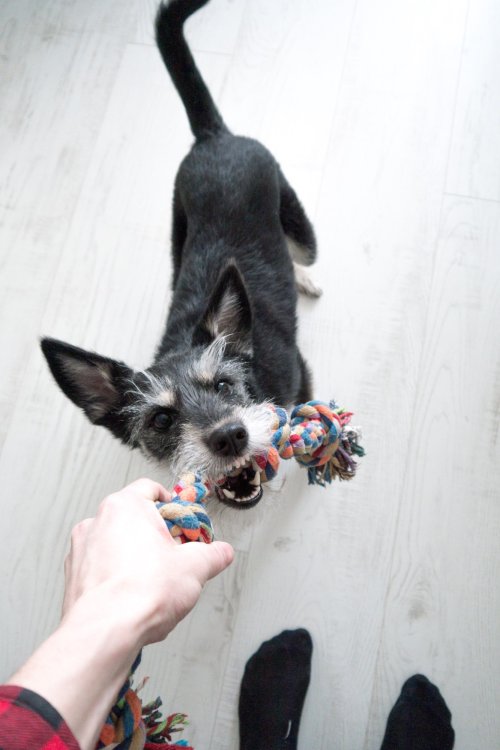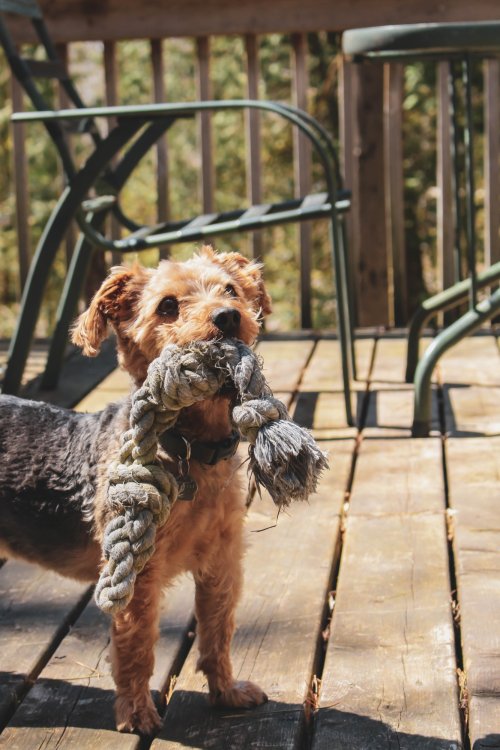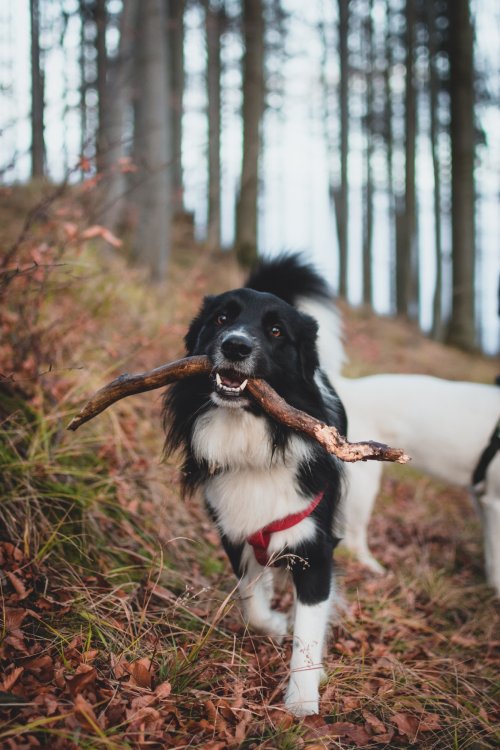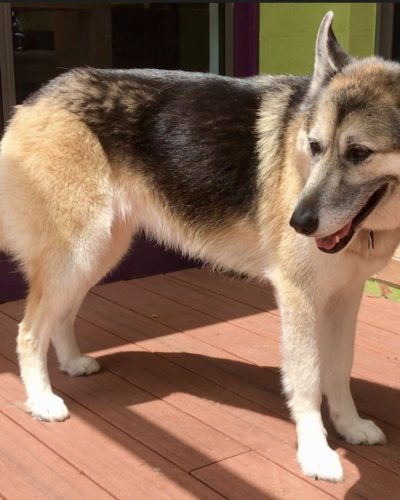The Biomechanics of Tug Part 1: Toy Selection
Playing tug with dogs is fun; handlers use this game for many reasons, including building drive, exercising and teaching. It can also help dogs’ natural prey-drive instincts. However, playing tug safely with your dog is sometimes overlooked. This article looks at some of the mechanics involved in tug toys, helping you to select an appropriate toy.
Playing Tug with your Dog Safely
What are tug toys?
Coming in various sizes, shapes, materials and colours, tug toys are readily available to buy and be made at home. These toys are used in the game of tug, where the handler and dog both grasp the toy at opposite ends, applying opposing pulling forces.

Dogs often have a personal preference for tugging toys, engaging more readily with one style over another. They may even decide that your smelly socks are their favourite! Anything could make a tug toy if you and your dog can grab and pull it. However, that doesn’t mean it’s safe.
Tug toys should withstand the applied forces without breaking or causing harm to the dog or handler. Also, they should be manufactured from a material that is non-toxic and does not pose a risk of choking (such as those containing beads) or penetration (such as an object with a sharp edge). So, how do we select a suitable tug toy for our dog?
Tug toy - selection

Two things to consider when choosing a tug toy are; the design and the materials. The tug should be an appropriate size and shape for your dog's mouth. The length, width and material of the toy will all affect how comfortably and securely the dog can grasp the toy in their mouth. Similarly, the material the toy is constructed from should suit the dog; their strength, personality, and build all play a role in the style of tugging they like best. Consider these material properties when selecting a tug toy; does the toy stretch, is it stiff, rigid, or abrasive, and can it withstand the dog’s bite force without tearing?
Short tug toys:

Some dogs are especially sensitive to non-contact pressure; as you move into their space, they move away, while others are less so. These more sensitive dogs may be more inclined to release rather than tug a short toy. Since your hand and their mouth are in close proximity when tugging with a shorter toy, their urge to release and move away from the pressure can be greater than their desire to play. Selecting a longer toy may be a better option for these dogs.
Short toys may also be inappropriate for mouthy dogs or those that lack the skill to avoid inadvertently contacting the handler with their teeth. Conversely, a short toy might be entirely appropriate for dogs that can securely grasp the toy (and not your hand) and prefer a more static game of tug, with equal opposing forces holding the handler and dog in an isometric exercise.
Long tug toys:
Long toys can be dragged along the ground as the handler runs or flicked about to entice the dog to chase. These toys are often used to build the dog's level of arousal, motivation or drive as they move about, attempting to catch the toy.
However, sudden changes in direction cause peak accelerations, corresponding to peak forces or loads transmitted through the dog's limbs, which is a risky type of play. It is easy to inadvertently exceed the body’s natural limitations resulting in injuries such as stress, strain, fracture, or dislocation. Thus, care must be taken when playing with long toys; avoid the temptation to encourage sharp, sudden turns, but rather engage the dog with smooth continuous flowing motions.

Thin tug toys:
What is a thin toy to one dog may be a thick toy to another. There is such diversity in the size and shape of dogs that we must consider the width or thickness of the toy in relation to the size of the dog's mouth.
A toy that is too thin may be difficult for the dog to grasp, increasing the risk of friction burns or abrasions to the delicate tissue within the mouth as the toy slides or slips through the jaw. Furthermore, a thin toy may get wedged or stuck between teeth causing pain and injury to the mouth and gums.
Some toys are flat and wide; the dog doesn’t need to open their jaw fully to grasp the toy. Toys of this shape ensure there is plenty of surface area, allowing the dog to gain a better grasp of the toy over a wider area of its mouth. When selecting a thin, wide toy, consider how much grip the dog will have on it; if they cannot depress the toy sufficiently with their teeth, it may still slide.

Thick tug toys:
Thick toys allow the dog to gain a firm grasp on the toy, as there is more surface area in contact with the mouth. However, a toy that is too thick can strain the muscles that activate the jaw or cause hyperextension of the temporomandibular joint (TMJ).
Correct and efficient functioning of the TMJ hinge joint is vital for the dog's well-being. Any injury to here can prevent the seamless opening and closing of the jaw, a necessary function for eating, drinking, and cooling by panting. Some dogs are more susceptible to injuries in the TMJ than others; long-muzzled dogs, due to the length of the mandible, have a long lever which means smaller forces can have a bigger impact at the hinge of the jaw. Short-muzzled dogs, such as brachycephalic breed breeds, are also more prone to TMJ issues since they must extend or open their jaw more widely to create space in the mouth for a thick toy.
Select a toy that fits comfortably within the dog's mouth, being neither too thin nor too thick.

Non-elastic tug toys:
A non-elastic toy may be a good option for static tugging, where reducing the movement of the limbs and spine is desired. A short, stiff toy limits the dog from moving its head and neck from side to side. When using this type of toy, short and stiff, consider the strength of the dog vs that of the handler. Where the dog can easily overpower the handler, it is the arm and shoulder of the handler will suffer and may become injured.
Think of short, stiff toys as strength building – and ensure the handler can safely control the game by limiting the dog's movement. This becomes an isometric exercise, increasing strength through muscle contractions with little movement.
On the other hand, a long stiff toy creates a long lever arm, so again, the handler vs dog’s strength should be considered. Forces applied by either party via a long non-elastic toy will create large torques to joints. Avoid strong, forceful tugs with these toys when the handler cannot safely control the game.

Elastic tug toys:
Toys that are elastic in nature have ‘give’ and recoil in them like a spring. This provides extra sensory fun for the dog. Getting the balance right, though, means considering the individual dog, their size, shape, strength, and preferred tugging method. We must also consider the preferences and abilities of the handler too.
When highly elastic toys are used within the limits of their flexible length – the forces transmitted through the toy to the handler and dog are reduced. This means there is much more wiggle room or room for error.
Elastic toys are great for dynamic tugging, involving speed and agility. Be aware, though, that once the toy reaches its maximum extended length, there may be a sudden sharp jolt as the toy becomes non-elastic; hitting this boundary unexpectedly can hurt.
Tug Toy Strength:
When we talk about the strength of a material, we consider its ability to resist permanent deformation; in the case of tug toys, we have both a biting action and a pulling force. Thus, there is the risk of
1. The dog biting through the toy
2. The toy splitting, breaking, or disassembling due to pulling forces
Reducing the risk of these events occurring can be done by selecting appropriate toys for the dog. Consider the bite strength of the dog; if they are timid, you might opt for a softer toy that allows the toy to compress easily in the dog's mouth. On the other hand, canines with powerful bite strength will need toys that can resist permanent deformation from the bite and prevent the teeth from penetrating the toy's surface. If teeth can penetrate the toy's surface, there is a risk of getting stuck in the dog's mouth or creating an area of weakness in the toy that shortens its life span.
Similarly, brittle or fragile toys may not cope with the applied forces and break upon tugging. Any breakage or disassembly that occurs during tugging can result in sudden increases in acceleration, drastically altering the forces on the dog and handler. This poses a risk of a slip or fall occurring. Inspecting toys regularly to ensure they are in good order and selecting a toy that is appropriate for the dog is well advised.
Material of tug toys:
There are so many options when choosing a material for your tug toy. Some examples are:
- Rubber
- Rope
- Webbing
- Woven fleece
- Sewn fabric
- Sheepskin
- Or a combination
One of my dogs prefers to play tug with an old slipper; it has a fluffy top and soft sole, making it pliable and easy to grip. You can get creative with toys, remember to play tug safely, and think about your dog, their preferences, strength, and size.





Leave a comment